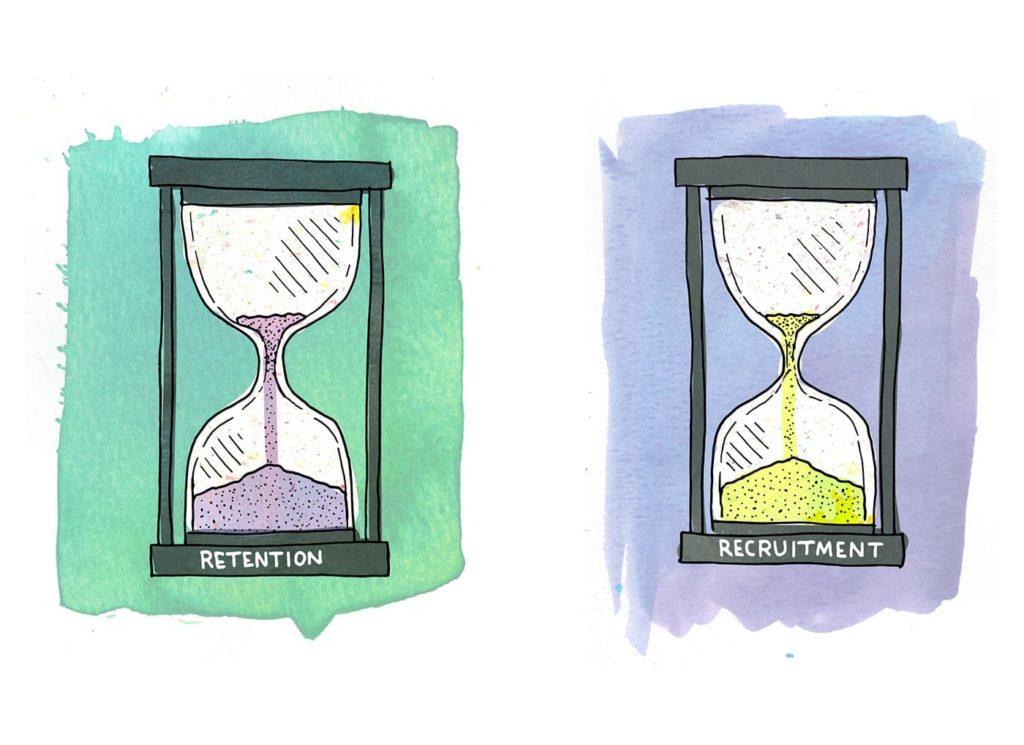Plenty has been written about the acceleration of physician and nursing workforce shortages. As the population continues to age, baby boomers are retiring in droves and creating greater demands for care with multiple chronic conditions. This, coupled with the resurgence of nursing turnover and insufficient numbers of nurse educators, is creating a workforce crisis. The recruitment and retention of clinical talent will consume more time, energy and resources for marketers, clinician leaders, and administrators for years to come.
While we may not be able to address all of the causes, we can address key areas to support our organizations through targeted and intentional marketing.
Retention
Retention has become a growing issue among nurses and physicians due to burnout as much as aging out of the workforce. These caregivers affect quality, safety, patient satisfaction and profitability every single day. Yet organizations spend few resources focused on the caregiver experience.
For physicians, administrative tasks consume a disproportionate amount of time, increasing the workload while reducing job satisfaction. According to Medscape’s 2018 Physician Burnout and Depression Report, as well as Advisory Board’s own research, the EHR is the leading cause of burnout because of the time physicians spend completing bureaucratic tasks. Given EHRs will continue as the hub of clinical and administrative productivity, tremendous improvements are needed, and marketing should play a role.
Questions to consider:
- Is your organization tracking physician and nursing engagement to identify changes in burnout and depression?
- Can you identify physician groups who could benefit from training to be far more efficient using your EHR?
- Do you have a project management team to tackle this training initiative?
- Is your EHR as user-friendly as it could be? Has your vendor been asked to address inefficiencies?
- Are you utilizing other members of the care team sufficiently so physicians can work at the top of their license?
- Have you considered finding a voice recognition support or scribe service to ease the burden on physicians?
In addition, you likely already have an employee engagement research tool that can break out engagement by job title. Have you added a qualitative component to better understand the ‘why’ behind the numbers for physicians? Assessing the root causes puts you in a far better position to find solutions.
Working with Human Resources, you may be able to develop solutions around these root causes. Communication and organizational culture will likely become part of the solution.

Tait Shanafelt, MD, became the first Chief Physician Wellness Officer at Stanford Medicine, an academic medical center. While creating and hiring this position may not be in your scope, understanding the importance of this role in the organization is something you may influence.
For nurse retention, understanding root causes goes a long way toward finding solutions. Using qualitative research, focus groups or other research tools can help identify the drivers of discontent and ultimately turnover.
For younger nurses, residency programs have been proven to be effective in improving retention and lowering turnover. These programs bridge the current gap between classroom education and true hospital training. In many organizations, these programs have paid for themselves by reducing the cost of turnover.
Mentoring programs can also go a long way to help young nurses. Experienced nurses have so much to offer young nurses, but often there is not a program to create these opportunities. Mentoring programs allow both senior and junior nurses to feel they are making a greater contribution.
Finally, empowerment in process improvement engages nurses of all levels of experience. Inefficiency is still common in most health systems. Empower those performing the jobs to improve the processes. Provide employees a venue to be heard and recognized for their efforts. Use daily huddles to drive process improvement throughout the organization.
Recruitment and Retention
The reality of supply and demand for clinical talent means you are competing with every other organization for talent both among physicians and nurses. As a marketer, you are often in the position of supporting recruitment with marketing and communication. Communicating your competitive advantage is part of the job.
If your organization is not a highly recognized leader or a well-known regional player, you may feel the uphill battle to attract top talent. Authenticity in marketing will support recruitment and retention.
For example, while it may be more challenging to attract talent to more rural areas, there is also an appeal to the quality of life provided in a rural community, for some people. What you may perceive to be your weakness can be turned into a strength. Cost of living, more land, and minimal traffic are clear strengths to some professionals.
This is where authenticity comes in. It is hard to recruit people to a small town or rural area by trying to make it appear bigger and more cosmopolitan. The fact that there is a Cheesecake Factory nearby does not make your town seem like a hub for hipster foodies.
Instead, focus on the characteristics of your organization and your community that truly make it special. In a rural health system, you may know your coworkers better. They may even be neighbors. Employees do not have to fight heavy traffic to get to work, and parking is likely a non-issue compared to urban environments. While work-life may be just as busy, the pace of life outside of work may be a real selling point to many.
If your organization truly lives your core values, there is an authenticity to sharing them and how they come to life. If there are aspects to the culture of your organization that make it unique, let candidates see behind the curtain. Candidates will self-select based on what is important to them.
When talent is attracted to the true benefits of your organization and community, they are far more likely to find the transition more rewarding and fulfilling. Which is when they will call your brand ‘home’.
To read about each of the trends disrupting the health care industry, download the complete 2019 Health Care Marketing Trends Report.


